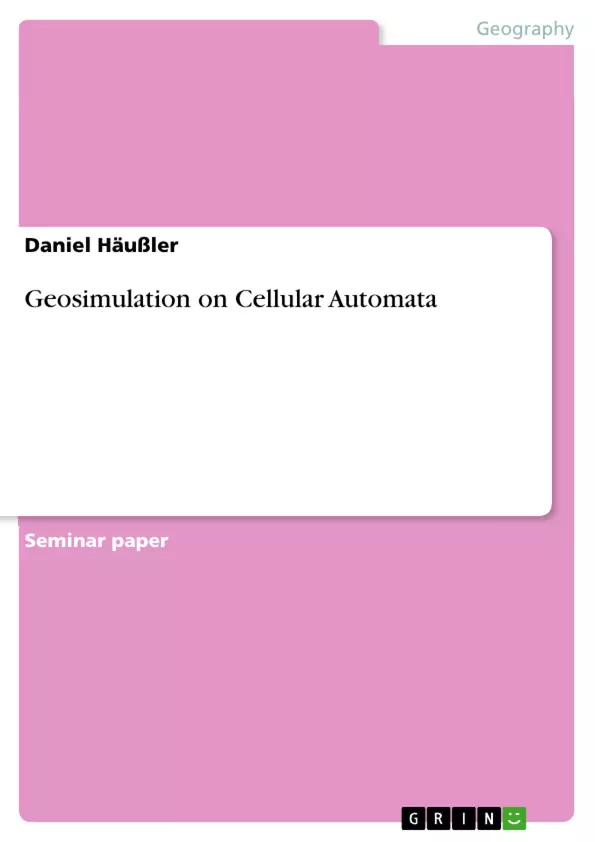The following paper will cover an overall view of cellular automata. Due to the fact that the method will be considered from the outset, it is accessible not only for specialists. Further I tried to broach the history of cellular automata and the first well-known application "Game of Life". Moreover a practical application will illustrate the potential of cellular automata on the basis of a NetLogo forest fire model. In addition to a short analysis of this geosimulation, a continuative and deeper going paper will be mentioned. After this example, interested readers should be able to appraise the value of cellular automata’s implementation. Finally, the work will be rounded off with the mention of the most significant disadvantages and problems.
The idea to simulate the behavior of animate beings is as old as the invention of computer itself. As we can easily imagine, the method of cellular automata has a lot of applications in physics, chemistry and biology. Scientists in these subjects gladly apply cellular automata because issues follow more deterministic models than in social sciences. In the following chapters I will try to illustrate to what extent the cellular automata could also be used in other subjects, especially in geographical matters. Human geography is often concerned with topics originating sociology, economy, urban development, crisis management and other issues which cannot only be explained by numbers and formulas. Nevertheless the method of cellular automata can be useful to understand some important issues.
An essential problem is the fact that in our digitalized world local development is not necessarily solely based on its direct neighborhood. The model of cellular automata suggests that we have access to every direct neighbor but does not account for direct influences from beyond. On the other hand, such additional factors, for which you would have to identify new rules again, would produce amounts of data exceeding the capabilities of the model
Inhaltsverzeichnis (Table of Contents)
- INTRODUCTION – WHY DO WE USE GEOSIMULATION AT ALL?
- CELLULAR AUTOMATA AS A METHOD NOT ONLY FOR NATURAL SCIENCES
- A HISTORICAL BACKGROUND OF CELLULAR AUTOMATA
- THE OPERATION OF CELLULAR AUTOMATA
- The Cell
- The Neighborhood
- The States
- The State Transitions
- The Homogeneity
- THE \"GAME OF LIFE\"
Zielsetzung und Themenschwerpunkte (Objectives and Key Themes)
This paper presents a comprehensive overview of cellular automata as a method for geosimulation. It aims to explain the fundamental concepts, historical development, and practical applications of cellular automata, making the topic accessible to a broad audience beyond specialists.
- Introduction to the concept of cellular automata as a tool for geosimulation.
- Historical development of cellular automata, including its early use in biology.
- Detailed explanation of the core components of cellular automata: cells, neighborhoods, states, and transitions.
- A practical illustration of cellular automata through the "Game of Life" model.
- Discussion of the potential and limitations of cellular automata in various fields, including geography, physics, chemistry, and biology.
Zusammenfassung der Kapitel (Chapter Summaries)
- INTRODUCTION – WHY DO WE USE GEOSIMULATION AT ALL?: This chapter introduces the concept of geosimulation and highlights its benefits in simplifying complex real-world scenarios. It discusses the use of cellular automata as a method for extracting essential rules and simulating different scenarios.
- CELLULAR AUTOMATA AS A METHOD NOT ONLY FOR NATURAL SCIENCES: This chapter emphasizes the applicability of cellular automata beyond natural sciences, particularly in social sciences like geography, sociology, and economics. It illustrates the method's potential to model and understand complex issues.
- A HISTORICAL BACKGROUND OF CELLULAR AUTOMATA: This chapter traces the historical development of cellular automata, focusing on the groundbreaking work of John von Neumann and Stanley Ulam in 1966. It also introduces the "Game of Life," invented by John Hortin Convay in 1970, as a seminal example of cellular automata.
- THE OPERATION OF CELLULAR AUTOMATA: This chapter delves into the fundamental components of cellular automata, explaining the concept of cells, neighborhoods, states, state transitions, and homogeneity. It provides visual representations of different grid types and neighborhoods.
- THE \"GAME OF LIFE\": This chapter showcases the "Game of Life" as a classic example of cellular automata. It describes the basic rules governing cell survival and death, highlighting the emergent properties of the model. The chapter also provides a visual representation of the model's development.
Schlüsselwörter (Keywords)
Cellular automata, geosimulation, Game of Life, modeling, simulation, spatial analysis, emergence, complexity, neighborhood, states, transitions, homogeneity, grid, torus, natural sciences, social sciences, geography, biology, physics, chemistry, urban development, crisis management.
- Quote paper
- Daniel Häußler (Author), 2014, Geosimulation on Cellular Automata, Munich, GRIN Verlag, https://www.grin.com/document/454918



